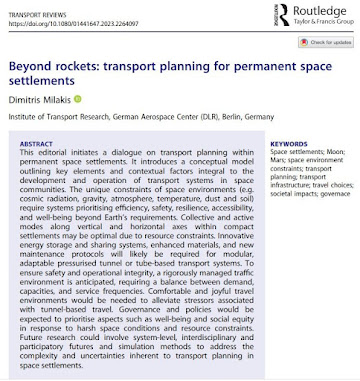Beyond rockets: transport planning for permanent space settlements
My recently published editorial in Transport Reviews initiates a dialogue on transport planning within permanent space settlements. It is motivated by Phase 3 space exploration (Sustained lunar opportunities) that will follow Phase 1 (Boots to the moon) and Phase 2 (Lunar exploration - expanding and building) of the International Space Exploration Coordination Group (ISECG, 14 Space Agencies) roadmap for expanding human presence from low Earth orbit to the Moon and Mars. Here are the key takeaways:
1️ Conceptual Model: A conceptual framework that outlines the key elements and contextual factors for the development and operation of transport systems within space habitats has been introduced.
2️⃣ Space constraints: Transport in space settlements will face challenges like cosmic radiation, varied gravity conditions, temperature fluctuations, and more. This requires systems that prioritize safety, efficiency, resilience, accessibility, and well-being far beyond Earth's requirements.
3️⃣ Optimal Transport Modes: Given the resource limits in space, focusing on collective and active transport modes, both vertically and horizontally within compact settlements, might be the best approach.
4️⃣ Innovative Infrastructure: Modular, adaptable, with redundant critical systems to ensure continuous operation even when certain modules fail, would be needed. These would demand innovative energy storage, improved materials, and new maintenance protocols.
5️⃣ Traffic Management: A rigorously managed traffic environment will be key for safety and operational integrity. A well-balanced system among demand, capacity, and frequency would be required.
6️⃣ Comfort and Well-being: Moving through tunnels would be stressful. So, creating a transport environment that offers comfort and joy becomes critical.
7️⃣ Governance and Policies: A focus on human well-being and social equity, in response to the social, psychological and physiological effects of space habitats as well as the necessary shared effort for survival could translate into equitable access to all sectors of the settlement (habitation, research, recreation, resources), affordability (e.g., minimum amount of travel credits), and physical and digital accessibility for all to the transport system.
8️⃣ Future research: Future studies would need to focus on system-level and interdisciplinary research methods, including futures studies and simulations, to deal with the deep uncertainties of transport planning in permanent space settlements.
1️ Conceptual Model: A conceptual framework that outlines the key elements and contextual factors for the development and operation of transport systems within space habitats has been introduced.
2️⃣ Space constraints: Transport in space settlements will face challenges like cosmic radiation, varied gravity conditions, temperature fluctuations, and more. This requires systems that prioritize safety, efficiency, resilience, accessibility, and well-being far beyond Earth's requirements.
3️⃣ Optimal Transport Modes: Given the resource limits in space, focusing on collective and active transport modes, both vertically and horizontally within compact settlements, might be the best approach.
4️⃣ Innovative Infrastructure: Modular, adaptable, with redundant critical systems to ensure continuous operation even when certain modules fail, would be needed. These would demand innovative energy storage, improved materials, and new maintenance protocols.
5️⃣ Traffic Management: A rigorously managed traffic environment will be key for safety and operational integrity. A well-balanced system among demand, capacity, and frequency would be required.
6️⃣ Comfort and Well-being: Moving through tunnels would be stressful. So, creating a transport environment that offers comfort and joy becomes critical.
7️⃣ Governance and Policies: A focus on human well-being and social equity, in response to the social, psychological and physiological effects of space habitats as well as the necessary shared effort for survival could translate into equitable access to all sectors of the settlement (habitation, research, recreation, resources), affordability (e.g., minimum amount of travel credits), and physical and digital accessibility for all to the transport system.
8️⃣ Future research: Future studies would need to focus on system-level and interdisciplinary research methods, including futures studies and simulations, to deal with the deep uncertainties of transport planning in permanent space settlements.
Open access: download

